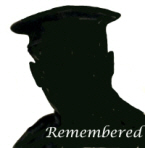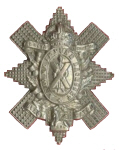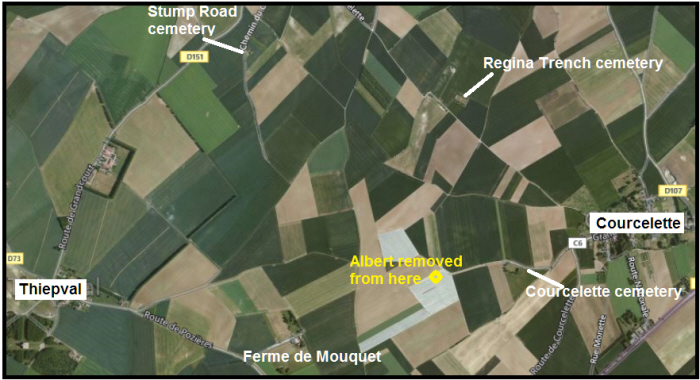



No.427669, Private, Albert JENNINGS
Aged 26

|
Albert JENNINGS was born at 2 Burton End, Haverhill on 31st December 1889 (Risbridge Q1-1890 4A:681), baptised in St Mary's on 16th March 1890, son
of Walter Thomas and Sarah Ann Jennings (née RIDGWELL). 1891 census...Aged 1, he was at 2 St Botolph's Place, Burton End, Haverhill with his father Walter JENNINGS [32] thong maker; his mother Sarah [34] born Helions Bumpstead; sisters Elizabeth A [9] and Ada J [7]; brothers Walter T [5] and Frederick G [3]. All except his mother born in Haverhill 1901 census...Aged 11, he was still at St Botolph's Place with his parents; sisters Elizabeth (jacket machinist), Ada (drabbet weaver), Edith [9] and Beatrice [7]; brothers Walter (brewer's drayman, Frederick (errand boy), William [4] and Harry [2]. The new siblings all born in Haverhill. 1911 census...Aged 21, he was 'boots' at the Rose and Crown, Haverhill, licensee William Elles whose son Octavius was killed on the Somme earlier see here , also there was Ernest Whybrow, the billiard market who died in Belgium in 1916 in the Suffolk regiment. see here His parents had moved to 38 Camps Road, Haverhill with his sisters Ada Jane (weaver), Edith Ethel and Beatrice (both weavers) and Florence [8] born Haverhill; brothers Frederick George (pig keeper), William (van boy) and Harry. All ten children survive. At present it is not known when he went to Canada. |

|
The South West Suffolk Echo of 21st October 1916 reported that:- "Mrs. W. Jennings, of 38 Camps Road, has been officially informed that her son, Pte. Albert Jennings of the Canadian Regt., was killed in action on the 16th. September. Pte Jennings had been employed at the Rose and Crown prior to his leaving for Canada " He enlisted in Regina, Saskatchewan on 21st September 1915, a single farm hand born in Haverhill UK on 31st December 1889. Next of kin his father at 38 Camps Road, Haverhill. 5 feet 5 inches (165.1 cm)tall, chest 32.5" to 35.5"(82.6 to 90.2 cm), brown eyes, dark brown hair, Church of England. Initially in the 46th Overseas Battalion, he sailed from Halifax, Nova Scotia on 23rd October 1915 on the SS "Lapland" and arrived in Devonport on 30th October.Posted with the 42nd battalion to France on 9th June 1916. He soon was laid low by influenza and admitted to 8th Canadian Field Ambulance on 24th June and forwarded to No 10 Casualty Clearing Station. The next entry on his records is "return from base, 16th September 1916. Sadly he was killed that same day, in what was quite possibly his first ever action. His body was found as shown below, no cross on the grave but identified by his disc and re-interred a few yards away at Courcelette cemetery in March 1919.. No "circumstance of death" card for him has been found. It was the second half of the Battle of the Somme and the battle for Courcelette was raging.. The attack was renewed on 16 September but without any real success. The Guards suffered heavily, making an unsupported attack, and had to be relieved. XV Corps attacked at 9.25 a.m. 14th Division was let down by the artillery, and after an ineffective bombardment was unable to make any progress. The 21st Division attack began bogged down passing around Flers and so fell too far behind the artillery barrage, and their only tank was destroyed by a shell. Brigade HQ in Flers was also destroyed by shellfire. The New Zealand Division fought off a German counter-attack, and then made some headway before being ordered to halt when news came through of the failure to their right. III corps also made little progress. The field where Albert's initial grave was found contained a mix of graves from Empire troops and British, several unidentified. They were all reburied next to one another in Courcelette in 1919. On 21st October, 1916 the South West Suffolk Echo reported that his parents had been officially informed that his death occurred during a charge against the Germans when he was struck from machine gun fire and killed instantaneously. A letter from the Chaplain of the Battalion said, "He is buried on the field with many other comrades …. I think he could have found no more honourable resting place than on the field where he served so splendidly". |
Visitors need to be aware none of these three cemeteries are on a road to anywhere

the so called roads quickly peter out into chalk tracks not wet weather routes!
click here to go to the Commonwealth War Graves Commission website for full cemetery/memorial details